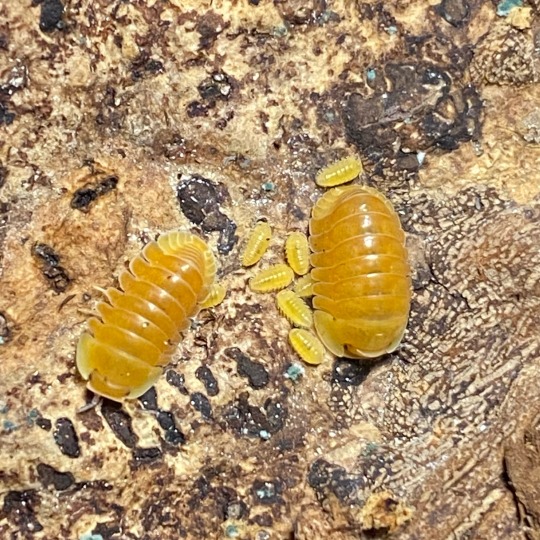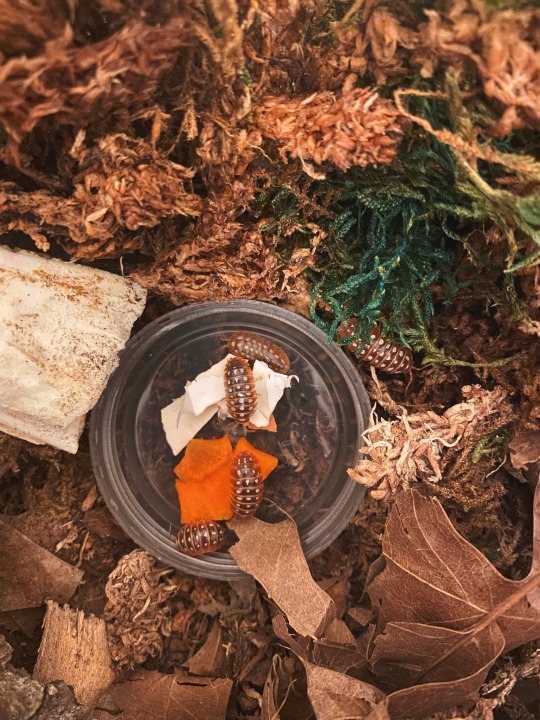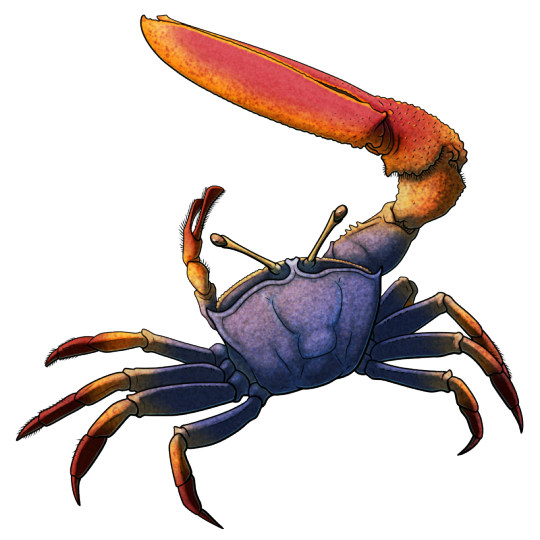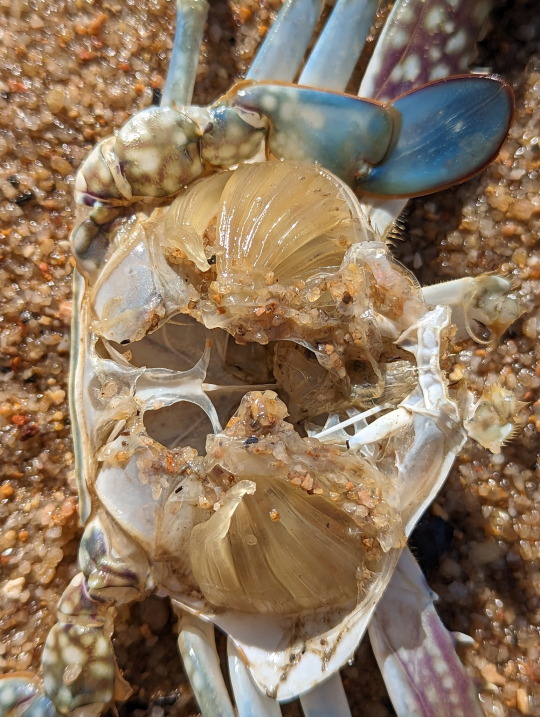#crustacea
Photo

Poissons - Félix Bracquemond - 1866 - via The British Museum
3K notes
·
View notes
Text

A shield shrimp (Triops australiensis) in Kimberley, Australia
by Ian Bool
#shield shrimp#tadpole shrimp#shrimp#crustaceans#triops australiensis#triops#triopsidae#notostraca#branchiopoda#crustacea#arthropoda#wildlife: australia
1K notes
·
View notes
Photo

1K notes
·
View notes
Text

Strange Symmetries #13: The Hermit Crab Cycle
Hermit crabs are crustaceans that first appeared at the start of the Jurassic, about 201 million years ago. Despite their common name they aren't actually true crabs, instead being a classic example of convergently evolving a crab-like body plan via carcinization.
They also have noticeably asymmetric bodies, with abdomens that coil to one side and differently-sized front claws.

Pagurus bernhardus by Arnstein Rønning | CC BY 3.0
And while modern hermit crabs are famous for inhabiting scavenged snail shells, their fossil record suggests this wasn't always the case.
Originally, they seem to have lived in ammonite shells.
Palaeopagurus vandenengeli lived in what is now northern England during the Early Cretaceous, about 130 million years ago. Around 4-5cm long (~1.6-2"), it was found preserved inside the shell of the ammonite species Simbirskites gottschei.
Its left claw was much larger than its right, and together they would have been used to block the shell opening when it was hiding away inside. And while the exact shape of its abdomen isn't known, it probably asymmetrically coiled to the side to accomodate the spiralling shape of the host shell.
Hermit crabs seem to have switched over to using gastropod shells by the Late Cretaceous, around 90-80 million years ago, possibly due to marine snails developing much stronger sturdier shells during this period in response to the increasing prevalence of specialized shell-crushing predators. The more upright snail shells would also have been much easier to drag around the seafloor than ammonite shells – and meant that they were ultimately less affected by the total disappearance of ammonites during end-Cretaceous mass extinction.
———
NixIllustration.com | Tumblr | Twitter | Patreon
#science illustration#strange symmetries#paleontology#paleoart#palaeoblr#palaeopagurus#paguridae#paguroidea#hermit crab#anomura#decapod#crustacea#arthropod#invertebrate#art#carcinization
981 notes
·
View notes
Text


Photos 1-2 - Specimen 1


Photos 3-4 - Specimen 2


Photos 5-6 - Specimen 3
D. senex hermit crabs residing in empty Moon Snail shells.
13/08/23 - Diogenes senex
QLD:WET - Flying Fish Point, low tide sandy bay
#invertblr#invertebrates#Arthropods#Arthropoda#Diogenes senex#Paguroidea#Hermit Crabs#Decapoda#Decapods#Crustacea#Crustaceans#hermit crabs#crabs
60 notes
·
View notes
Text
#crustacean#crustaceans#crustacea#arthropods#shrimp#prawns#crab#lobster#crayfish#shrimps#lobsters#crawfish#isopods#barnacle#prawn#arthropod#fish#silly#garlic bread#🍉🦐🍉
21 notes
·
View notes
Text


an exciting surprise!! my blonde duckies produced their first offspring!
#upload#isopods#rubber ducky isopod#isopoda#crustacea#animalia#invertebrates#pet isopods#cubaris#cubaris sp
25 notes
·
View notes
Text

Sapphirina spp.
Photo by Solvin Zankl
#sapphirina#sea sapphire#sapphirinidae#copepods#marine#ocean#sea#marine life#marine invertebrates#crustacea#crustaceans#macro photography#animals#nature
23 notes
·
View notes
Video
Skeleton shrimps on contracted Metridium actinia by Alexander Semenov
#skeleton#shrimp#Caprella#caprellidae#skeletonshrimp#ghostshrimp#ghost#crustacea#amphipoda#Metridium#actinia#contracted#underwatermacro#underwaterphoto#sea of japan#flickr#alexander semenov#photographer#nature
50 notes
·
View notes
Photo

..
#dark academia#animals#biology#natural history#decapoda#marine#crustacea#dark aesthetic#tiere#natural history museum#naturkunde#underwater#naturkundemuseum#museum aesthetic#museum#dark#dunkel#animal#tier#aquatic#biologie#arthropoda#frankfurt#academia aesthetic#crayfish#lobster#crab
24 notes
·
View notes
Text


They really like carrots and eggshells! 🥕
#isopod#isopods#crustaceans#crustacea#invert#invertebrate#invertebrates#arthropoda#arthropods#entomology#bugblr#insectblr#beaus bug biome#beaus bugs
111 notes
·
View notes
Photo

Lehrbuch der Zoologie : für höhere Lehranstalten, die Hand des Lehrers und für alle Freunde der Natur - Otto Schmeil - 1930 - via e-rara
1K notes
·
View notes
Photo

A red reef lobster (Enoplometopus occidentalis) off the coast of Kona, Hawaii, USA
by Pierrette Wagner
#red reef lobster#reef lobsters#lobsters#crustaceans#Enoplometopus occidentalis#Enoplometopus#decapoda#Malacostraca#crustacea#arthropoda#wildlife: hawaii#wildlife: usa
432 notes
·
View notes
Text

Good Crab 🦀
13 pcs/pzs
167 notes
·
View notes
Text

Strange Symmetries #20: The 16 Million Year Fiddler Crab Rave
Many decapod crustaceans have slightly asymmetrical pincers, often with one claw being chunkier and specialized for "crushing" while the other is more slender and used for "cutting".
But fiddler crabs take this sort of asymmetry to the extreme as part of their sexual dimorphism – males have one massively oversized claw, which is used for both visual display to potential mates and for physical fights against rivals.
Some of the earliest fiddler crabs are known from the Miocene of what is now northern Brazil. Although the fossils have been given several different taxonomic names since their discovery in the 1970s (including Uca maracoani antiqua, Uca antiqua, and Uca inaciobritoi) they're currently considered to be indistinguishable from the modern Brazilian fiddler crab, Uca maracoani, meaning that these crabs have remained externally unchanged for the last 16 million years.
Up to about 4cm in carapace width (~1.6"), modern Uca maracoani are found in coastal mangrove swamps and tidal mudflats around the northern and eastern coasts of South America – and some of these environments have also undergone little change since the Miocene. Males of the species can develop their enlarged pincer on either side of their bodies, with lefties and righties seeming to occur in equal numbers.
———
NixIllustration.com | Tumblr | Twitter | Patreon
#science illustration#strange symmetries#paleontology#paleoart#and also not paleoart#palaeoblr#uca maracoani#brazilian fiddler crab#fiddler crab#ocypodidae#brachyura#crab#decapod#crustacea#arthropod#invertebrate#living fossil#art#crab rave
319 notes
·
View notes
Text


Photos 1-2 - Carapace, washed up 10-15m away from body


Photos 3-4 - the rest of the body


Photos 5-6 - closeups of claws


Photo 7 - flattened hind leg / Photo 8 - the other legs


Photo 9 - closeup of carapace / Photo 10 - internal structure beneath carapace
Dead crab that washed ashore. The carapace had detached from the rest of the body and washed up separately, but its still a clear match in my eyes.
You can see how its last legs are modified (or flattened I guess) for swimming.
17/09/23 - Portunus sp.
QLD:WET - Cardwell, ocean shore
#Arthropods#invertebrates#invertblr#arthropod#arthropoda#Portunus#unidentified#Portunidae#Swimming Crabs#Decapoda#Decapods#crabs#dead tw#Crustacea#Crustaceans
22 notes
·
View notes
